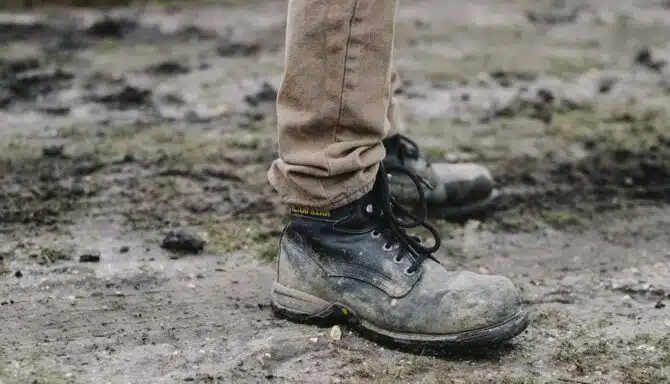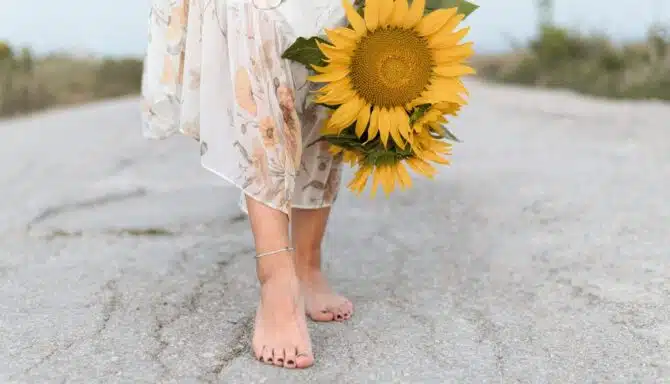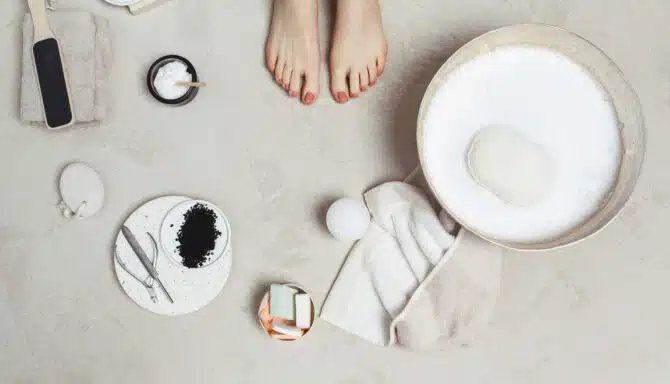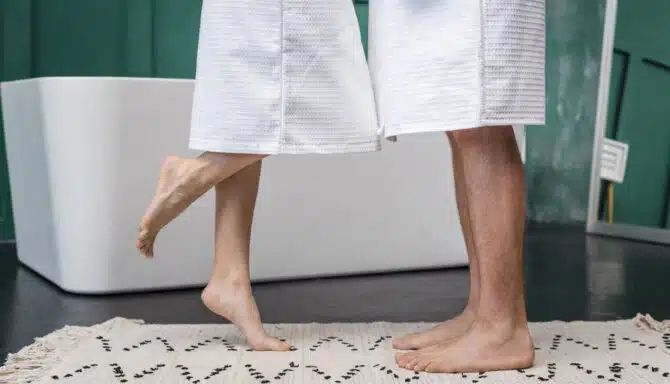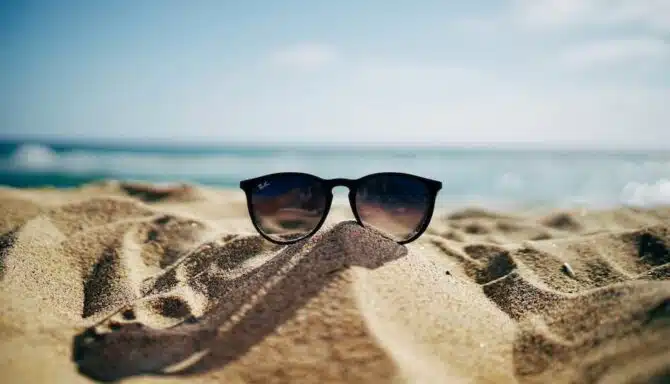June 27, 2024
Construction workers face challenging demands on the job site, including long hours, potential safety hazards, and variable weather conditions. There are few jobs where footwear is more important than on a construction site. Proper footwear is critical for comfort, safety, and overall health.
This blog explores how to find the best shoes for construction workers. We dive into the balance between durability, safety features, and foot health, which are vital for your job.
Durability
Construction sites are full of heavy equipment and sharp objects and tools. Hazards range from sharp objects to heavy machinery. The best shoes and boots for construction workers should be durable, made from leather or synthetic blends, and be able to withstand abrasions and falling objects. Keep your toes and feet safe with toe caps or sturdy outsoles - ideally both.
Refined safety features
Safety is a top priority on the job site. When choosing footwear, opt for models that meet or exceed industry safety standards set forth by the Canadian Centre for Occupational Safety and Health.
Features like steel or composite toe caps provide essential protection against impact and compression injuries, while puncture-resistant midsoles shield your feet from sharp objects on the ground.
Additionally, slip-resistant outsoles help prevent accidents on wet or slippery surfaces, reducing the risk of slips and falls. Refer to the CCOSH's guide for symbols, or markings, on footwear to determine which is appropriate for the job.
Comfort
Long hours spent on your feet can be grueling. It's not uncommon for construction workers to be on their feet for 10+ hours per day. Shop for shoes with adequate support through the arch and heel, and invest in removable insoles or orthotic inserts for even greater support. If you're a construction worker in Toronto, our licensed chiropodists can do a biomechanical assessment to determine the best insoles for your foot condition.
Grip and footing
The type of flooring used in the workplace influences comfort, especially on feet. Unforgiving surfaces like concrete are the least comfortable to work on—your feet and legs absorb all the impact compared to a softer surface. Further, slippery floors (whether smooth or wet) are hazardous for slips and falls. If not careful, you can be exposed to injuries like sprained ankles or broken foot bones.
Fit
Durability and safety features are effective only when your shoes fit the contours and mould of your foot. When trying construction footwear, test out the fit with the same socks and attire you'd be wearing on the job site. If you decide to purchase online, we recommend using the manufacturer's sizing guide for directions, or finding a local retailer to try the shoes on in-store.
June 24, 2024
Oh no, yellow feet! This seemingly alarming skin pigmentation is not usually cause for concern and is far more common than you think. Yellow feet commonly present as yellow bottoms of the feet and are usually not an immediate emergency. That said, they should be looked at during a foot assessment as there may be underlying medical causes or dermatological conditions at play. Let’s review the top culprits for yellow skin on the bottom of your feet.
Calluses and Corns
If the yellow skin on your feet feels hard to the touch and only occurs in certain spots (the whole foot isn’t yellow), you probably just have a lot of thick calluses!
Imagine your feet are like well-trodden paths; the more you walk on them without protective footwear, the thicker and tougher they become, forming “callused armour” which often has a yellow hue.
One of the most well-known podiatric concerns, calluses can be treated if they become a problem for hygienic reasons and also to prevent them from becoming more painful, infected or ruining your skin’s integrity and strength.
Corns can also cause thick, yellow skin.
Calluses and corns can be easily removed by a chiropodist using sterilized, medical-grade equipment. Read more about how our chiropodists treat calluses.
Hyperkeratosis
A dermatological condition called hyperkeratosis causes excessive hard and yellow calluses that can cover the majority of the bottom of your foot. When combined like this they can be a lot worse than solitary calluses and are more likely to crack, bleed, and hurt.
Carotenemia
You are what you eat! And in this case, you may be eating too many carotene-rich foods (like carrots, sweet potatoes, pumpkins — anything orange!) if the entire bottom of your foot has a mild, yellow hue. The good news? This is harmless.
While noticing this effect on the bottom of the feet can be disconcerting, it may also occur on your face, which might have a positive effect on your confidence. Studies show these mild, facial skin changes can contribute to the overall appearance of health and vitality in humans. Pretty cool!
Jaundice
Jaundice is a serious occurrence that points to a poorly functioning liver, gallbladder or pancreas. Your doctor will help you determine the root cause.
A tell-tale sign that you’re experiencing jaundice is if the yellow colour is quite strong, and if the whites of your eyes are also yellow (sclera).
If you don’t have any other symptoms outside of mildly yellow feet, it’s unlikely you have jaundice, but it’s better to be safe than sorry!
Fungal Infections
Athlete’s foot causes flaky and itchy skin clusters around your toes and the ball of the foot. They look red or pink when irritated, but sometimes turn whitish yellow. Don’t try to treat this at home - you might damage your skin and nail health. Seek guidance from your local Toronto foot clinic instead! They can point you towards the right ointments, creams and other treatments. Learn more about treatment and prevention.
Anemia
This medical condition affects your red blood cells and impairs oxygen flow throughout your body. The entire foot or entire bottom of the foot will have a bright, yet mild, yellow tint. If your feet are cold to the touch in addition to being yellow, you might have anemia.
May 13, 2024
Summer foot care and pedicures - can you name a more iconic duo? Showing off a sleek pedi is one of the best ways to enjoy the warm months. But safe pedicures differ greatly from your run-of-the-mill cosmetic pedicure, so it’s important to be on the lookout for the safest way of avoiding pedicure infections. We’ve got 3 pedicure safety tips you should follow before you hit the salon!
Top 3 Pedicure Safety Tips
Choose clean salons or foot clinics
Avoid certain tools
Practice aftercare
Choose Clean Salons or Foot Clinics
Only visit nail salons that demonstrate good practices. Be on the lookout for:
An organized workspace.
Equipment sanitization protocols. An autoclave with steam sterilization is best.
Employees visibly maintaining hygienic standards.
Employees using disposable liners in the foot baths, and cleaning and filtering them between uses.
Fresh linens (if applicable).
Clean floors and surfaces.
Clean uniforms on employees.
Clear labels on products.
Clients wearing protective footwear when walking around.
Another good tip is visiting your nail salon when they first open in the morning, when everything is cleanest!
Pedicures at Feet First Clinic
Foot clinics are where you can get a medical pedicure, which tends to be safer than a cosmetic pedicure.
Appointments don’t happen in communal areas, unlike salons, so you’re already in a safer environment with less people spreading contagious fungal infections. And although you’ll be skipping the polish (you can always apply it yourself afterwards!) and foot bath (again, you can do this at home - foot baths at nail salons are not hygienic, especially if the bath has jets), you’ll be enjoying so much more than you can get from many salons. This includes:
Guaranteed use of sterilized, safe tools.
A thorough cleaning of the entire foot with alcohol.
An inspection of your feet from a chiropodist who can recognize foot conditions.
Thorough cleaning of dead skin(onychophosis) under the nails.
Callus softening or removal.
Learn more about what happens during a medical pedicure and the differences between a cosmetic vs. a medical pedicure.
Avoid Certain Tools
Nail technicians in salons use many tools, but you should kindly request they skip some of them. One of these is the foot rasp or “grater” they use to scrape the bottom of the feet. It can be overly abrasive and damage the skin, leading to irritation and cuts. Strong skin is a barrier for contaminants, and damaged skin welcomes dirt and infections.
To protect your feet even more, you can skip tools that don’t appear to be properly sanitized or cleaned between uses, or avoid tools with visible signs of wear and tear.
Practice Aftercare
After getting your pedicure, it’s up to you to keep on top of proper foot care! Here’s what to do:
Avoid tight shoes that crowd the toes. This can cause ingrown toenails.
Wash your feet every day with gentle soap before thoroughly drying.
If you must cut your own toenails, only trim straight across, avoiding shaping.
Moisturize and exfoliate your feet.
Wear clean cotton socks and change them frequently.
May 9, 2024
One often overlooked but crucial aspect of personal hygiene is foot care. Your feet carry you through countless activities but don't always receive the attention they deserve when it comes to cleanliness. In this article, we delve into the importance of foot hygiene and tips for keeping feet clean and healthy. From simple daily practices to preventing infections, we’ll explore this aspect of foot health care together.
Wash Your Feet Daily
First thing’s first, lather up your feet! Use mild soap every day to wash your feet either on their own or while in the shower or bath tub. This not only eliminates dirt and keeps your feet feeling fresh, but if you come in contact with tinea pedis soap and water may be able remove the fungus before it becomes athlete’s foot.
Keep Your Feet Dry
If you fail to keep your feet dry you’re welcoming a wide array of issues. Not only does moisture cause foot odour, but it also creates the type of environment foot fungi love and thrive in. It also leads to skin maceration, blisters, cracking, and peeling. Give your feet a good dry with a nice soft towel. Pay extra attention to the hard-to-reach areas in between the toes, and to go the extra mile, let them bask in the air or in front of a fan.
Moisturize Your Feet
Moisturizing hydrates the feet and fights excessively dry skin. When your skin is too dry it can create fissures and cracks that welcome dirt. So, while keeping your feet dry is essential, remember not to overdo it and turn them into the Sahara Desert!
Wear Clean Socks and Rotate Footwear
Keeping your feet cooped up in dirty socks is a recipe for persistent foot odour and moisture. For the ultimate foot refresh while on the go, change your socks throughout the day.
This also applies to your footwear, especially for less breathable shoes. To avoid having to change your footwear all the time, look for light runners and walkers with perforated holes that let fresh air in and out.
Trim Your Toenails
You may be wondering what your toenails have to do with foot hygiene. Trimmed toenails are less likely to harbour dirt and fungus, while also looking great! Jagged edges and too-long nails can also pierce your socks, which ruins their protective purpose. Learn how to trim your nails like a pro here.
Protect Your Feet in Public Areas
Swimming pools, locker rooms, communal showers — you’re putting yourself at risk of contracting a fungal infection if you frequent these places. If you can’t avoid them, protect your feet with shower shoes and flip flops to keep funky fungi at bay!
May 6, 2024
Summertime means storing those winter boots and slipping into your favourite warm-weather footwear. But before you hit the beach or embark on a summer hike, remember that giving your feet the care they deserve is not just essential; it's the key to thoroughly enjoying all your summer adventures — whether at the beach, pool or outside exercising! Your feet are your foundation for summer fun, so let's ensure they're in top shape with proper summer foot care.
Here are some simple yet effective tips to keep your feet happy and healthy during the hot months ahead. These easy-to-follow tips can significantly impact your foot health, giving you the confidence to easily step into summer.
1. Keep your feet and yourself hydrated
Like the rest of your body, your feet need hydration. Ensure you drink plenty of water to prevent dehydration, reducing the risk of dry, cracked skin on your feet. Additionally, apply a hydrating lotion or cream to your feet every day to keep them soft and supple.
2. Choose breathable footwear
Sandals or breathable shoes encourage air circulation and prevent feet from overheating. Avoid plastic or synthetic materials that trap moisture and produce sweaty, smelly feet.
3. Protect your feet from the sun
Apply sunscreen to your feet, particularly when exposed to the sun for extended periods. Like the rest of your body, your feet's skin is susceptible to sunburn. Use a broad-spectrum sunscreen with an SPF of 30 or higher before heading outdoors. Consider re-applying every two hours and more regularly if swimming or sweating. See the Canadian Dermatology Association's list of products that adhere to their standards.
4. Keep your feet clean and dry
Summer heat can increase the risk of fungal infections like athlete's foot. To prevent this, wash your feet daily with soap and water. Then, dry thoroughly, especially between the toes. Use a foot powder to absorb moisture, reducing the risk of fungal growth.
5. Trim your toenails (properly)
Untrimmed toenails can lead to discomfort and increase the risk of ingrown toenails, especially during summer activities. Trim your toenails straight across. Avoid cutting them too short, and file any rough edges to keep them smooth. Doing so can help prevent ingrown toenails.
6. Give your feet a break
Summer is the perfect time to kick off your shoes and let your feet breathe. Take a moment to walk barefoot on the soft grass or sand to strengthen your foot muscles improve circulation and reconnect with nature. Just be mindful of your surroundings to avoid any injuries or stepping on sharp objects.
7. Stay active this summer with the proper footwear
Whether going for a hike or a run, wearing the right shoes for the activity is important. Proper footwear provides support and cushioning to reduce the risk of foot pain or injury, so invest in a good pair of athletic shoes that fit well and suit your chosen activity.
8. Treat your feet to a relaxing soak
After a long summer of fun, treat your feet to a soothing foot soak to relax tired muscles and rejuvenate your skin. Fill a bath or basin with warm water. Then, add Epsom salt or a few drops of essential oils (like lavender or peppermint) for an extra touch of luxury.
9. Pay attention to warning signs
If you experience persistent foot pain, swelling, or any worrisome symptoms, don't ignore them. These could be signs of a foot condition or injury requiring medical attention. Consult a chiropodist or healthcare professional for proper diagnosis and treatment.
10. Practice good foot care year-round
Finally, remember that foot care is not just for summer. Make it a habit to take care of your feet year-round by wearing comfortable, supportive shoes, maintaining good foot hygiene, and promptly addressing foot issues.
By following these tried-and-tested tips for summer foot care, you can keep your feet happy, healthy, and ready for all the season's adventures. These tips have been proven to work, so you can trust that your feet are in good hands. So go ahead, put your best foot forward, and confidently enjoy everything summer has in store!
April 22, 2024
When it comes to anti-aging routines, our feet are often overlooked. Yet, they are one of the hardest-working parts of our body and deserve just as much attention as our skincare regimen.
As we age, our feet undergo natural changes that can lead to discomfort and mobility issues if left unchecked. In this blog post, we'll explore age-defying foot care tips to help keep your feet feeling youthful and vibrant at any age.
1. Maintain proper hygiene
Good foot hygiene is the foundation of age-defying foot care. As we age, our skin becomes thinner and more susceptible to infections, making it essential to keep our feet clean and dry to prevent fungal infections and bacterial growth. Wash your feet daily with soap and water, paying close attention to the spaces between toes, and thoroughly dry them afterward to prevent moisture buildup.
2. Moisturize regularly
Dry, cracked skin is a common issue that affects aging feet. To keep your feet soft and supple:
Moisturize them regularly with a rich foot cream or lotion.
Focus on areas prone to dryness, such as the heels and soles, and consider using products containing ingredients like urea or shea butter, known for their hydrating properties.
For an extra treat, indulge in a weekly foot soak followed by a moisturizing foot mask to pamper your feet and lock in moisture.
3. Supportive footwear
As we age, the fat pads in our feet naturally thin out, leading to decreased cushioning and shock absorption—this is known as fat pad atrophy. Investing in supportive footwear with ample cushioning and arch support is crucial for maintaining foot health and preventing discomfort. Look for shoes with a roomy toe box to accommodate any changes in foot shape, and opt for styles with adjustable straps or laces for a customized fit. Additionally, consider wearing orthotic inserts or custom-made orthotics to provide extra support and cushioning.
4. Consistent exercise
Like the rest of our body, our feet benefit from regular exercise to improve strength, flexibility, and circulation. To keep your feet limber and mobile, incorporate simple foot exercises into your daily routine, such as toe curls, ankle circles, and calf stretches. Additionally, consider practicing yoga or tai chi, which can help improve balance and stability, reducing the risk of falls and injuries as we age.
5. Routine and regular check-ups
Regular foot exams are essential for detecting foot problems or underlying health issues early. Schedule regular check-ups with a chiropodist or foot specialist to monitor your feet's health and address any concerns promptly. They can provide valuable insights and recommendations tailored to your needs, helping you maintain healthy, youthful feet for years.
